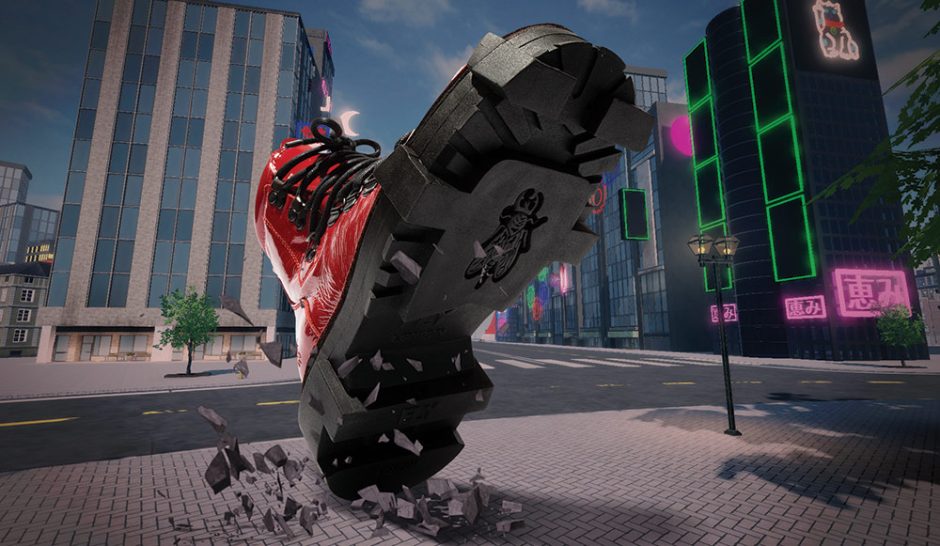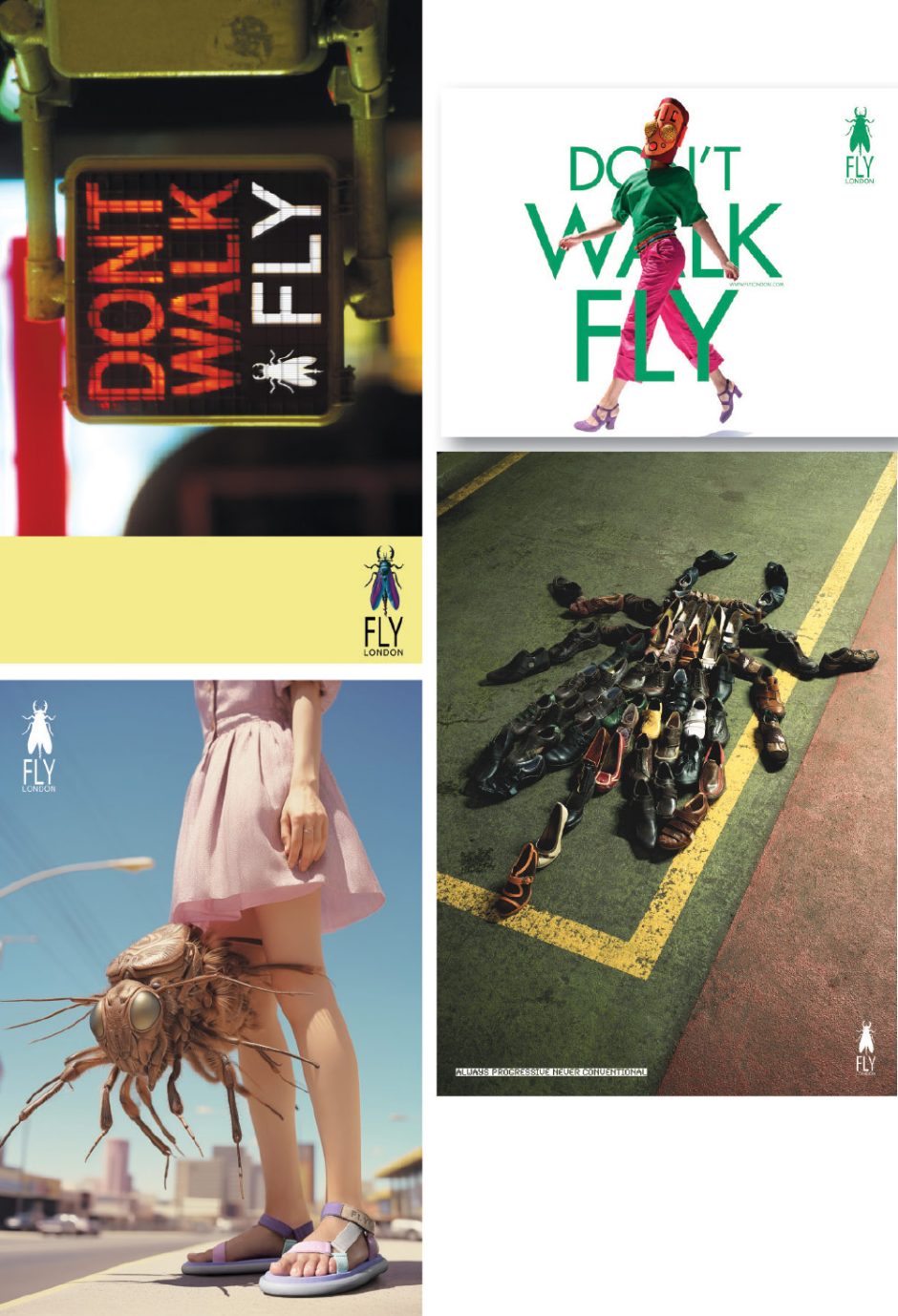
When most people come across a fly, the instinct is to swat the little pest or stomp on it with a shoe. Flies are creepy and by all accounts (think Jeff Goldblum in The Fly) downright gross. Thus, one would assume the hairy, bug-eyed insect doesn’t scream suitable logo for a footwear brand.

Unless you’re Fortunato Frederico, founder and co-owner of Fly London. Because, as the brand’s origins go, he and then junior partner, Amilcar Monteiro, came across an oversized black fly logo on a booth at the GDS show in Düsseldorf, Germany, and instantly fell in love. Well, love might be a strong word, but Frederico saw big potential in Fly London. He was intensely intrigued about the possibilities. The name was catchy and irreverent. The huge black fly logo was striking. The fact that there weren’t even shoes on display—the owners had a falling out—didn’t matter. For Frederico, it was all about that name and logo. The shoes would come next. He made an offer to buy the brand on the spot. Deal!
So what if the design team at his Kyaia factory in Portugal had only made private label since opening in 1984. Frederico was chomping at the bit to make that leap into the branded arena. He reasoned that if the team could make great shoes for the brands it served, then it could for Fly London, too.
“I liked the idea that from then on, we could ‘fly,’ after 10 years of working on private label,” Frederico says. “As the logo and image were suggestive, we felt that we could explore international markets and saw a great opportunity to grow exponentially, which has been the case.”
Thirty years later, Fly London is sold in 57 countries, having made a name for itself offering comfort with ’tude styling in men’s and women’s. Its edgy collections of boot and sandal wedges have become the brand’s calling card and are perennial best-sellers. Some silhouettes, in fact, have been in the line for 15 years, selling year after year with fresh color and material updates. Not bad for a brand that started out as a tight collection of men’s styles and moved into women’s five years later. An early hit was a multicolored lace-up boot that had a retro alpine ski vibe. (It’s been updated, pictured above, as part of the 30th anniversary celebration.) It was the brand’s first success in women’s. Frederico sensed even greater potential going forward. “A storm is usually preceded by a strong breeze,” he offers. “When we went to market, we felt this breeze and knew that the storm was just around the corner.”
Fly London caught on fast in Portugal and then quickly took hold in Germany and England, attracting a young, cutting-edge crowd in love with its chunky soles and rounded toes. Think punk-meets-grunge-meets-club goers. “It’s always been an irreverent brand with an absolute commitment to creativity,” Frederico says.
A few years into its flight, Fly London took another big leap. Frederico reached out to one of its private label customers, Bos. & Co., about distributing the brand in North America. The Canada-based company had been steering its private label customers—like Dockers, Johnston & Murphy, and Stacy Adams—to Kyaia. Kevin Bosco, president, liked what he saw from the get-go—the name, the logo, and the shoes.
“Fortunato tapped me on the shoulder at a WSA Show in Las Vegas and said, ‘We have this new brand called Fly London. Do you think you guys are set up to distribute in Canada and the United States?’” Bosco recalls. “I said, ‘Yes,’ and 30 years later, here we sit.” (Bos. & Co. has since added Kyaia’s Softinos and Asportuguesas brands to its roster.)
Fly London was exactly what Bos. & Co. was searching for at the time. Namely, a brand that fit its target distribution of higher-grade independent boutiques and chains. The consumers shopping these locations sought something edgy, yet comfortable, and wouldn’t shy away from the premium price point. Bosco was confident Fly London had long-term potential based on these key attributes. Plus, there was Kyaia. “What we liked, first and foremost, was that we already knew the factory and the people involved,” Bosco says. “We had been working with them for several years with high-level brands, and we knew their attention to detail, quality, and reliability. Basically, we knew the shoes would be well-made.” He adds, “That made it an even easier decision.”
A Good Buzz

Fly London sales have grown steadily over the years, peaking in 2019 at 100,000 pairs in North America and 1 million pairs worldwide. The distribution, for the most part, hasn’t changed, nor its target customer. It’s middle- to high-grade independents, small chains, and select department stores such as Von Maur and Nordstrom. “Macy’s and Dillard’s aren’t in our stratosphere,” Bosco says. “They’d love to have our shoes but probably at about 50 percent of the price.”
Fly London’s consumer sweet spot in North America skews 35 and up. “It’s a wide and varied group who want fashion but aren’t willing to give up comfort,” Bosco explains. The challenge is to keep the brand fresh and exciting without alienating its core audience. “We can’t go too young because then we lose the buying power,” he says. “At the same time, our target customer demands comfort aspects without looking like a typical comfort shoe. That’s not an easy recipe to cook, but we’ve got good chefs in our factory.”
Sandra Bodnarchuk, owner of Zig Zag Fashions in North Vancouver, Canada, has stocked Fly London for 25 years. Not only is she a loyal dealer, she’s also a long-time wearer. The wedges, she discovered early on, relieved her foot pain. “As you get older, the fat goes off the ball of your feet and it hurts to walk in flat-soled shoes,” she says. “Fly London’s wedges keeep my feet off the ground. I’m not pounding the pavement with every step, and the gradient is comfortable.” Bodnarchuk sartorial choice serves as effective brand marketing. “Customers often comment on my ‘cool’ shoes,” she says, adding that the Bos. & Co. “Fly Days” have been another effective tool to get the word out. Twice a year, the brand reps present the new season collections to customers along with some giveaways in her store. Shoppers who purchase Fly London on those days also receive a bright yellow shopping bag with the iconic fly logo. “That’s another strength of this brand,” Bodnarchuk says. “Their yellow shoe boxes and bags…everybody knows it’s Fly London with that big fly right in the middle. You can’t miss it. Their marketing has been key to keeping them in business for 30 years.”
Fly London has great brand elasticity. It’s not pigeonholed by a particular style, category, or aesthetic. While renowned for wedges, it is one of those rare brands that sells a broad range of styles, including boots, flip-flops, slides, mules, trainers, loafers, and Mary Janes. It can even pull off Western booties without a hitch. Paulo Monteiro, product manager, says offering a wide variety is a necessity in today’s world. “Women don’t necessarily need shoes, so we need to create styles that make them think, ‘I don’t need to buy shoes, but I need to buy these shoes,’” he says. “That’s what we’re always looking for—creating shoes that women keep falling in love with.”
Great designs are a must. Equally important is Fly London’s quality construction and sustainability aspects. Kyaia uses traditional manufacturing techniques and the finest materials—all powered by 100 percent green energy and by producing minimal waste. The level of craftsmanship and care for the environment is part of the brand’s story. For example, Andre Noujaim, owner of Shoe Be Do in New Orleans, appreciates that, unlike many brands, Fly London sews on its heels instead of using harmful glues. “It extends the life of the shoes,” he says. “If someone falls in love with a pair that they can’t part with, they can be easily repaired.” Bodnarchuk adds that the Fly London’s quality is consistent. “There are no surprises. The collections evolve over the years, but the quality of the shoes is always the same.” Adds Ricardo Esteves, sales manager of Fly London: “What’s most important for us is that even if our best-seller is 17 years old, the goal is to always reinvent it by introducing new materials, colors, and solutions—like maybe making it more sustainable.”
That commitment to excellence extends to the customer service offered by Kyaia and Bos. & Co. It has enabled Fly London to build long-lasting relationships with its retailers. Noujaim describes Fly London’s support and staffing as fantastic. “As a merchant, if there is an issue, it’s quickly resolved and there’s no complications,” he says. “Their customer service is parallel to their quality products.” Gary Malkin, president of Kaufman Shoes in Memphis, TN, a carrier of Fly London for 10 years, puts it simply: “Their culture of doing business is admirable. They’re just good people!”
Flies in the Ointment
No brand survives 30 years without having to overcome obstacles. But the pandemic has been Fly London’s toughest challenge by far. Not only did it bring on a macro athleisure/slippers movement seemingly overnight, it upended supply chains that Kyaia is still grappling with. The brand is still trying to recapture the momentum it had in the years leading up to 2020. The war in Ukraine also hits much closer to home for the Portuguese company. “Ukraine is something we see on TV here, but we don’t really experience the effects of it on everyday life like they are in Europe,” Bosco says. “It’s quite a different story. It’s having a negative effect on business. Costs are up, as are the fears of the war spreading.”
All one can do is keep fighting the good fight. The sentiment harkens back to the Kyaia’s founding. As legend has it, Frederico, at age 14, started working at Campeão Português, a textile company that eventually became one of the country’s largest footwear businesses. At age 24, he went on to complete his military service in Angola, near a fire base atop a mountain named Kyaia. That’s when he made a deal with God that if he ever gets out of there alive, he’ll call his shoe factory Kyaia. A picture of the fire base hangs in the factory’s main sample room.
“The path to success has always been risky, but one I have sought to follow,” Frederico says. “In the early days of Fly London, taking risks and foreseeing the future were the reasons that made us grow.” He sees no reason to change course now. “We must continue to be innovative, fashionable, and fresh.” That blueprint lies at the core of Fly London’s long-running success. “Our destiny is to grow and strengthen,” Frederico says.



